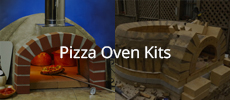X
-
You could try applying a stucco/render coat directly onto the blanket, but it is a very poor substrate to work to. A vermicrete layer as well as providing additional insulation, sets up firm and covers bumps in the blanket, particularly if the top of the oven has an extra layer which creates a step (as in post #261)Last edited by david s; 05-29-2025, 03:25 AM.
- Likes 1
-
Looking back, you have a rectangular hearth slab. Your oven is round. If I am correct, you will only be hanging over just a few inches for about a foot at the apexes of the sides and maybe the rear of the dome. That's not too much. Just lay down a piece of hardy board at those points to cantilever over those short spances. Reinforcement mesh in the first coat of stucco would be good to reinforce those areas.That's not just an opinion. I have done it lol.Last edited by Gulf; 05-28-2025, 09:34 PM.
Leave a comment:
-
Hey builders - I have a question on the use of vermicrete for the dome. I have 2" of ceramic blanket insulation around the entire oven and will layer an extra 1" blanket on top, which I understand will be the hottest area.
I read on another post that with 3" of blanket insulation the vermicrete layer could be skipped. My challege is that I'm nearly to the edge of my hearth in the back, I have about 1.5" available now for both the vermicrete and stucco.
Any thoughts on this situation? Can I skip the vermicrete and go directly to stucco, or perhaps thin down the vermicrete layer? Or would I be better off adding an extra 1" of blanket around the entire oven and then going straight to stucco?
Many thanks!
Leave a comment:
-
Memorial day weekend ends with my project feeling much closer to completion. I got started with insulation today. I came up a little short on material so it's back to the ordering more. I'm also hiring out a custom SS chimney transition, and there is chimney pipe to buy plus a cap. Chimney pipe is really expensive!
I was also looking for a vapor vent for the top of the dome. I know there are some less expesive options, but I found a vendor that manufactures marine grade stainless steel mushroom vents. It looks really nice, so I decided to get one. I connected with the owner and he will make one without the powder coat that the typically apply to avoid and risk of noxious odor at high temps.
I keep beaking parts of the opening arch. Yesterday I cracked one of the joints when I was getting in the oven to inspect my work. Then today I broke the joint on one of the bricks that was to be the base for chimney. I had to mix more mortar to fix that, as I used the last batch yesterday. And then while I was positioning it again the brick broke!
Then today I broke the joint on one of the bricks that was to be the base for chimney. I had to mix more mortar to fix that, as I used the last batch yesterday. And then while I was positioning it again the brick broke!  no worries, no one will ever see it. I decided my oven needs a break from me, so waiting for the next batch of materials is a good thing.
no worries, no one will ever see it. I decided my oven needs a break from me, so waiting for the next batch of materials is a good thing. 
Leave a comment:
-
david s - I'm not sure I understand the problem, besides weight. Does the higher thermoconductivity effec the oven performance? What effect does it have?
2mm seems very thin.
In other news, I closed the dome today! COULD I BE DONE WITH THIS STAGE? To be honest, I have doubts. The after the 11th course the remaining opening was too big for a 1 piect plug and too small to allow more that one more course. So I custom cut 4 pieces to plug the top.
There was a lot of trimming to get a good fit, and in the end my plug is a little uneven. But is seeled! I got inside the oven to check things out and noticed its a little uneven plus there was a pretty deep gap inside. I filled the gap with mortar.
Attach photos. Let me know if I need to have a redo.
- Likes 1
Leave a comment:
-
Steel has comparatively high thermal conductivity which will both heat and cool rapidly. At 1/2” thick you will have a lot of thermal mass there, effectively sapping the oven of heat as well as making the door very heavy and hot to handle. To overcome warping issues at baking and roasting temperatures, which can create sealing problems, mild steel needs to be relatively thick (approximately 2mm), but any thicker starts to introduce the other mentioned problems.Last edited by david s; 05-25-2025, 11:59 AM.
Leave a comment:
-
Made good progress on the oven today, and I'm confident I'll be closing the dome this weekend! FINALLY! haha
Today I rebuilt the opening arch. I'm custom cutting the bricks to provide a level, rectangular opening for the smoke box, which will transition to 8" stainless steel chimney. I finished front of that opening today, the back will come tomorrow.
Last night our blacksmith friend Arnon came over and inspected the progress. He'll be building my door, for which he plans to cut a 1/2" think sheet of steel to size. The door will have a slide damper, basket handles and coiled feet to for support. In addition he's forging a long-handled peal and coal rake.
Leave a comment:
-
Here is the outer arch with my form removed. Some of the lower bricks were tilted incorrectly, which I fixed as I was approaching the top of the arch. But looking at it now I'm thinking about taking it appart and redoing things between bricks 4 and 14.
Update: I was showing off the oven to my dad and he used the opening arch as a handhold and accidentally pulled it apart. So I guess that settles the matter; I'm rebuilding the opening arch. Last edited by Macrinehart; 05-12-2025, 02:10 PM.
Last edited by Macrinehart; 05-12-2025, 02:10 PM.
Leave a comment:
-
Hi David - well noted, and I have the rebate per your guidance, my outer arch bricks are cut lengthwise so the outer arch has less depth than the inner arch to create the reveal.
Leave a comment:
-
-
Well - I had to let the motar set up on my 11th course, so I jumped to the opening arch and just dove in I decided to put the 3.5" arch on the outside, with the throat to the chimney going back to the inner arch. I figure I can use the fiberglass rope gasket to help seal the inside arch, and I'll get some thinner rope gasket material to help get a good seal on the custom transition to the chimney. I think it looks pretty good.
Leave a comment:
-
This might be the weekend that I close the dome...
I'm about to head out, but before I do - I have a few questions on the outer arch, flue and chimney. With a 42" oven, I'm planning on 8" chimney (stainless steel), which has an opening area of about 78 sq inches. My plan is to have a rectangle opening in the outer arch, about 5.5" x 12", and to fabricate a custom flue transition. That leaves 3.5" of brick to work with around the front and/or back of the throat/opening. This presumes the depth of my outer outer arch is 9".
I also have 7/8" fiberglass rope gasket that I planned to use to seal between the inner and outer arches to allow some space for the dome to move.
Before I start cutting bricks for the outer arch, I want to verify this approach to the chimney opening is sound. Also, I'd like to know if I should have these very shallow arches in front and behind the flue transition? Or perhaps I should extend the depth of the outer arch with an additional course of bricks? Or maybe go for a wider opening, such as 5" x 16"?
Thanks for the advice!
Mac
Leave a comment:
-
That should work and luckily you do not really have that many to do. You really only need the do the conflicting area (inner dome area) say the first 1 1/2-2" and let mortar fill in the back side. IMHO, use the brick you bought.
Leave a comment:
-
I decided to experiment with one piece. Not sure on the results. On the positive side it fits very tight to the place its intended for. But the angle cut on the inner face means the bottom depth is reduced which causes the outside bottom to be recessed about a quarter inch inside the outer curve of the dome. Not sure if that is an issue?
Leave a comment:





Leave a comment: